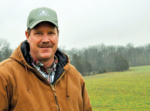Advertise Follow Us
Articles Tagged with ''soil moisture''
Holding Soil, Moisture Yields Greater Productivity
A combination of no-till and extensive cover crop use has the Gaspers’ hilly soils yielding better than they ever did when they were conventionally tilling.
Read More
Busting The Colder, Wetter Myth: Year 2
Soil temperatures were 0.1 to 1.75 F warmer in this no-tiller’s field during spring and summer compared to a neighbor’s conventionally tilled field.
Read More
Busting The ‘Colder, Wetter’ Myth With No-Till, Cover Crops
Scenarios in Indiana and Wisconsin seem to question the assumption that no-tilled fields with cover crops are slower to warm up and dry out than conventionally farmed soils.
Read More
Rolling, Crimping Can Help No-Tillers Use Covers Better
Well-designed roller-crimpers, and a good management plan, can help no-tillers and strip-tillers smother weeds, improve soil protection and get the most from high-biomass cover crops.
Read More




.png?height=125&t=1731942302&width=150)




